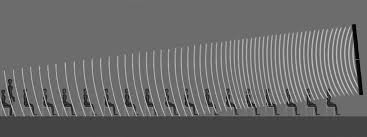Improving Results with Column Line Arrays
I had a design inquiry come in this week for a sound reinforcement system. Nothing out of the ordinary; basic box of a room, 50 wide, 70 deep, 18’ ceilings, drywall construction, 13 rows of seats on a flat floor. The application is primarily speech reinforcement with the need to occasionally rock out. The designer had selected a fairly common pair of conventional speakers to place left and right in the front of the room. I was asked to take a look at the design just to be a second set of eyes. The speakers they selected would have been fine, but a column line array would have been a better option. While line arrays in general have become the de facto standard for touring sound systems and are common in large format installations, compact and column line arrays seem to be one of the most underutilized speaker configurations. The reason we don’t see more line arrays in small to mid-sized installations even when suitable, is due to several factors.
- Old habits die hard. Point-source systems (conventional speaker boxes) have been around longer.
- The benefits of line arrays are sometimes not fully understood. Some of the benefits include:
- Improved control over vertical dispersion. This minimizes reflections off of ceilings and other structural surfaces thereby improving intelligibility and system performance.
- While point-source speakers adhere to the inverse square law (where direct SPL drops by 6dB every time you double the distance from the source) line arrays only lose 3dB every time you double the distance – at least within the near field. What this means is you may not need to blast people in the front of a room for it to be loud enough to hear further back.
- In some cases, it is possible to aim the sound to target the specific requirements of various locations within a venue. While this is often not available within a compact column line array, it’s worth noting as it relates to line arrays in general.
- The detailed characteristics of line arrays are sometimes not fully understood. I would argue that this applies to point-source boxes as well. Yet there is greater familiarity and hence comfort with the point-source boxes. (See Factor #1 – Old habits die hard)
- Size matters. The longer the array, the tighter the vertical control and the lower the frequency where control is available. If a room is highly reverberant, the recommended height of an array may be significant compared to room height itself.
- End users ignore good audio and think they know what a speaker looks like. Audio is usually noticed most when something doesn’t sound good. So most people ignore the audio system when things are going right. Since column line arrays can sound better than their conventional counterparts in the right application and they do not always look like conventional speakers, most end users would not even know they have seen/heard a column line array unless it was specifically pointed out to them. In many installations, they blend into the architecture and can be less visually obtrusive than conventional boxes – even when stacked relatively high.
While line array technology has been around for at least fifty years, it would appear from the information above that hesitancy to adopt has more to do with education or experience and less to do with the technology itself. If you work in the installed audio market, consider taking a closer look at column line arrays.
For a quick start, consider the following case study within a highly reverberant House of Worship.
“A Bose Panaray System Tames the Reflections Inside the Thorncrown Chapel”
After that, take a look at some of the products on the market (for example, the Bose MA12EX cited in the case study.) We suggested the Bose MA12 with sub augmentation for the “basic box of a room” mentioned previously.
If you would like to learn more about column line arrays, shoot me an email and we’ll steer you towards additional resources.







